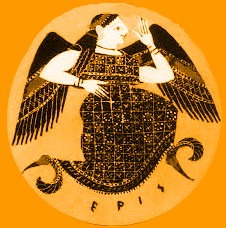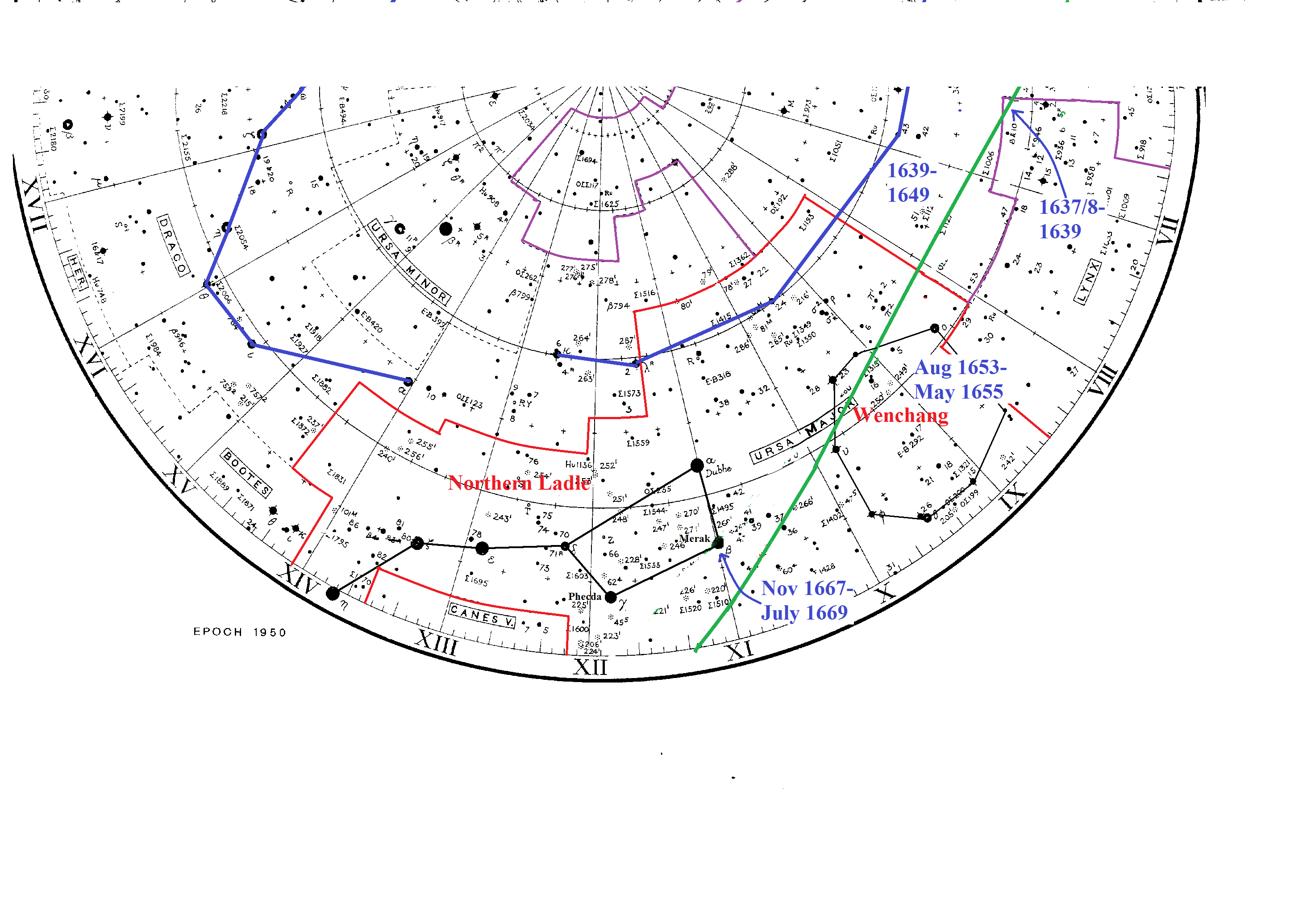



Eris (2003 UB313): The Light Bearer
Excerpts from an unpublished book
© Malvin Artley 2014
 Eris (136199 minor planet designation) is a scattered disc object, thought possibly to have a resonance with Neptune, although this has not been wholly confirmed.[1] She was discovered on 21 Oct 2003 when she was just over 5º south of the celestial equator in the constellation of Cetus (19í59), and as she began to make her approach to the ecliptic. Her orbital period is roughly 560 years. Eris has the most extremely elliptical orbit of any of the known dwarf planets except for ‘Snow White’ – (225088) 2007 OR10. Eris is essentially the same size as Pluto, but she is more massive, meaning that she contains more rock that Pluto, the latter being icier. Eris has one moon, Dysnomia.[2] The inclination of her orbit is also the most extreme of all the dwarf planets at almost 45° off the ecliptic. This means that for most of her orbit Eris transits outside of the zodiac, given her inclination. Knowing this fact, as we will see, Eris is the prime example of a dwarf planet that offers us new perspectives and which challenges our accepted ways of seeing astrology and ourselves. Eris is one of the little worlds that will begin to introduce a more spherical basis to astrology, a basis that the Chinese knew of in their ancient astrology, for they looked at the entire sky and not solely the planets and stars around the ecliptic…
Eris (136199 minor planet designation) is a scattered disc object, thought possibly to have a resonance with Neptune, although this has not been wholly confirmed.[1] She was discovered on 21 Oct 2003 when she was just over 5º south of the celestial equator in the constellation of Cetus (19í59), and as she began to make her approach to the ecliptic. Her orbital period is roughly 560 years. Eris has the most extremely elliptical orbit of any of the known dwarf planets except for ‘Snow White’ – (225088) 2007 OR10. Eris is essentially the same size as Pluto, but she is more massive, meaning that she contains more rock that Pluto, the latter being icier. Eris has one moon, Dysnomia.[2] The inclination of her orbit is also the most extreme of all the dwarf planets at almost 45° off the ecliptic. This means that for most of her orbit Eris transits outside of the zodiac, given her inclination. Knowing this fact, as we will see, Eris is the prime example of a dwarf planet that offers us new perspectives and which challenges our accepted ways of seeing astrology and ourselves. Eris is one of the little worlds that will begin to introduce a more spherical basis to astrology, a basis that the Chinese knew of in their ancient astrology, for they looked at the entire sky and not solely the planets and stars around the ecliptic…
The orbit of Eris is more or less square (perpendicular) to the plane of the galactic equator, which she crosses in the north in the constellation of Perseus at about 153º of galactic longitude, just past the star μ Perseii. In the south she passes the galactic equator in the constellation of Norma at about 332º of galactic longitude near the star γ2 Normae. To put this in a galactic perspective, the galactic center lies almost at the galactic longitude of 0°, which is in the constellation of Sagittarius near the star 3 Sagittarii at 17h46m RA and -29° declination[3]. What we call the galactic center is not actually a point, however, as it covers a large region between Scorpius, Ophiuchus and Sagittarius where the belt of the Milky Way is brightest.
Eris was the Greek goddess of chaos, strife and discord. Of interest is the Mars/Uranus conjunction in the discovery chart[4] which somewhat describes the influence of Eris astrologically. Also notable is a quintile triangle with Ceres at the apex and with Uranus and Pluto in quintile aspect at the base, as well as a septile triangle. Quintiles are known for their disruptive influence in mundane astrology, whereas septiles are a more benign influence, although they indicate special insight into matters. The equivalent in Roman mythology to Eris was Discordia. In the myth about her most frequently recounted,[5] Eris was the daughter of Zeus (Jupiter) and Hera (Juno), and she was prone to mischief and sowing discord. Due to that fact, when the Olympians were invited to a wedding between Peleus and Thetis, Eris was shunned at the entrance. Incensed that she was not invited to the wedding, she stormed away, but then returned, and upon her second arrival tossed a golden apple – which bore the inscription, “To the fairest,” – into the midst of the crowd. Three goddesses – Hera, Athena (Minerva) and Aphrodite (Venus) – went into contention for possession of the apple, with each believing that it must be one of them for whom the apple was meant.

The quarrel between the goddesses became so contentious that Zeus, seeking to wash his hands of the matter and not wanting to be caught in the middle, assigned Paris, a prince of Troy, to decide the matter. Paris was not very keen on the idea himself, but he had little choice, having been commanded by a god. Essentially, Zeus doomed Paris by placing him in the position of judge. Each of the goddesses sought to bribe Paris in order to influence him in their favor. Hera offered him political influence and power. Athena offered him infinite wisdom. Aphrodite tempted him with the gift of the most beautiful woman in the world – Helen, wife of Menelaus of Sparta (who was to become known as Helen of Troy). Without going much further into the myth, Paris decided to award the apple to Aphrodite, earning the scorn of the other two goddesses, eventually eloped with Helen, and the Trojan War was the end result, ending in the destruction of Troy and the death of Paris in the heat of the battle. I have left quite a bit out of the longer narrative, but this will suffice for our purposes.
If one looks into the myth a little and reads between the lines, Eris actually had quite an insight into her sister goddesses. She knew they were vain and she knew just how to get at them and in a way that would cause them acute anguish and precipitate a situation that would ruin the entire celebratory feel of the wedding, as well as souring the relationships between them. She succeeded quite admirably if one looks at it in terms of strategy. However, her actions also served to precipitate actions by others that were anything but desirable and which resulted in the complete destruction and sacking of the ancient city of Troy, thus greatly changing the political dynamics of the region. The reactions of the contending goddesses were shameful as well, as it was their actions which directly led to the war after the decision of Paris. Their scorn was deadly in its effects. Their story has a similar feel to the now-famous lines from William Congreve’s The Mourning Bride (1697):[6]
Heav'n has no Rage, like Love to Hatred turn'd,
Nor Hell a Fury, like a Woman scorn'd.
Of course, this applies in any situation where vanities in either gender are concerned.
There are several main themes in this myth that actually do speak to the action of Eris in a chart, though. To begin with, it was the discovery of Eris that caused the demotion of Pluto to the status of dwarf planet, because Eris may be a few kilometers larger in diameter than Pluto, and there were more and more objects in the solar system that were similar in size and composition to the two that were being discovered every year.[7] We could say without hesitation that the discovery of Eris caused discord in the scientific community about what actually comprises a planet and the distinctions between all planetary bodies. That is one of the main reasons why Eris got its name. Actually, though, the thing that stands out to me about this myth is not so much the discordant aspect of Eris’ actions, but more about political change and the actions that lead to such change. In modern times these same dynamics apply along with a rapid – we could say revolutionary – shifts in our consciousness, especially as that pertains to accepted or enforced modes of thought and social order. This is another aspect of the myth that is not addressed at all, and that relates to power dynamics and people in positions of power. It also relates to prestige, and it has been said that science, for instance, advances not by knowledge, but by prestige. If one is not published in the scientific community and accepted by one’s peers, then discoveries go unnoticed.
The beginning of a revolution is in reality the end of a belief.[8]
Gustave Le Bon (1841 – 1931)
…The primary lesson here was about the paths to which vanity and ego lead, as well as what can result from sowing discord among people of influence – destruction, war and discord on the whole. We will see more of the preceding dynamics of Eris in a chart when we look at her in her passage through the north celestial circumpolar region. However, from what I have seen with regard to Eris in a chart thus far, Eris gives us cause to step back and take another perspective on things other than the fondly held beliefs we have embraced from the past. She is like the lance to the boils in our ego and brings about a complete change of perspective on whatever sphere of belief or feeling she touches if we embrace her actions fully. She is the ‘bad cop’ in the good cop-bad cop scenario,[9] or the malcontent, and she is in some ways a combination of Mars/Uranus in her approach. She is ‘divine discontent’. Eris is anything but subtle in her effects, although she reveals a profound understanding of the subtleties involved in any situation or subject.
Eris has brought us new avenues in astronomy and other ways of looking at the solar system as a result through her recent discovery and her earlier transits... However, it does not stop there. As mentioned previously, she travels for most of her orbit outside of the plane of the ecliptic. It is as if she was shunned in the earlier stages of the formation of the solar system from the party of planets that enjoy the path of the sun. And now for us, she has been rediscovered and has thrown a golden apple into the midst of our deeply held notions about the solar system. That ‘golden apple’ has nothing to do with discord, however, although quite a bit of strife was generated in the scientific community and among astrologers with the actions taken by the IAU regarding the classification of planets after her discovery. In this case the ‘golden apple’ of Eris’ myth represents an expansion of knowledge and wisdom, even though at the same time it pricks at the egos of people who have strong opinions of how things should be. Not even the old gods like Pluto escaped her influence in this modern go-round with Eris. In the earlier part of the 20th century it was Pluto who introduced new concepts into our understanding of astronomy and astrology, and now in the 21st century it is all the dwarf planets, brought about by the discovery of Eris.
The orbit of Eris in her journey from her nadir in the constellation Pavo has taken and will take her through the constellations of Indus, Tucana, Grus, Phoenix, Sculptor, Cetus (where she is now), Pisces, Aries, Perseus, Lynx and finally to Camelopardalis, where she will reach her apex. No one in this century will experience Eris away from the ecliptic. She is currently less than 3° of declination south as of this writing (2015) and will continue within orb of the ecliptic for the remainder of this century. In other words, she will be within the realm of the zodiacal declinations that we now normally use in astrology (± 23.5°) She touches the ecliptic roughly every 289 years alternately in the signs Taurus and Scorpio. Eris will eventually reach a point just outside the walls of what the ancient Chinese astronomers called their Purple Palace, indicated by the heavy dark blue lines in the chart below. There she will make a short sojourn and then return to the outer regions of the Emperor’s realms, figuratively speaking. No other known planetary body used in astrology has this sort of orbit, and only she reaches into the north and south circumpolar regions. This has a great significance for those who would wish to investigate the matter, and we will touch on a little bit of why shortly.

…In our current understanding of astrology we do not have the observational history in place to interpret the influences of other constellations as Eris passes through them aside from their zodiacal influences, or any of the other planets…for that matter, simply because on the whole we have not taken the time to try to interpret anything outside of the known ecliptic. I am speaking here in terms of astrology as it is practised in the West. In the West we look at Eris as an influence largely as it is projected onto the ecliptic, and in that term ‘projected’ we get more of an idea what Eris really means in astrology currently. Up until now, the ecliptic has represented our conditioning in astrology to the largest extent via the signs. The major planets as they pass through the signs and make aspects to each other represent influences upon our consciousness. The ecliptic represents reality as it has been passed down to us through the eons. However, it is a big universe out there and the plane of the ecliptic represents only a small slice of that reality. What if we could incorporate the realities into our everyday consciousness represented by Eris, for instance, as she brings in the imaging of those other constellations through which she passes, instead of seeing only our projected thoughts as to what her influence might be? Does Eris project onto the ecliptic, or do we project what we know from our experience with the ecliptic onto Eris, for example? Do we get any ideas? Well, there are other zodiacs out there other than the one that we know, and these other dwarf planets…to the largest degree, are the lenses through which these erstwhile unknown factors are being conveyed to us. We will be dealing with these projections for a long time to come until we know the full truth.
I will give a little example of what I mean here to illustrate the points made in the previous paragraphs. For those readers who may have come across the works of Alice A. Bailey and some other works on esoteric astrology, much is made of the constellation of the Great Bear, Ursa Major. It is said to be the origin of the seven primary energies[10] that condition all consciousness in our local universe via the seven stars of the ‘Big Dipper’, the defining asterism of the constellation. The Chinese made much of it, too, and called it their ‘Northern Ladle’, using it for referencing a number of principle stars in their astrology from the angles formed by the main stars of the asterism, among other things making of it the ‘chariot of the Emperor’ and also their ‘Government’,[11] the latter of which has great significance as we will shortly see. In fact, Ursa Major is one of the ‘universal’ constellations, being recognized as a bear by many cultures.[12] Eris had entered the current boundary of Ursa Major fully in 1652.[13] Those readers of Alice Bailey’s books might ask as well if Eris passes by any of the main stars of the Great Bear or in close proximity. In fact she does, passing over Merak (β Ursae Majoris) and then passing just under the cup of the Northern Ladle thereafter. Referring to the star chart above, she skimmed by Merak in August of 1668 and will do so again in about 200 years hence.
However, there is another asterism[14] in the Great Bear that Eris enters, and it is a most interesting little group of stars, especially symbolically considered. Looking at it from the Earth, to the right of the cup of the dipper there is a group of stars arranged in a circle, which the Chinese called Wenchang Kung – the ‘Literary Palace’, or their ‘Administrative Center’ – and Eris passes right through the top of that asterism as she starts her journey southward. And, she was there for a period of around thirteen years, from 1653 – 1666.[15]
When we say that Eris passes through a constellation, what would that mean to us? What would Eris transmit to us in that case? The stars that comprise Wenchang are υ, θ ,φ, ο (Muscida), 15 and 23 Ursae Majoris. Since Wenchang is an Oriental asterism, and one that represents an administrative arm of the Chinese emperor, it may interest the reader to know that in the 1640s in Tibet, the 5th Dalai lama[16] (the so-called ‘Great Fifth’), introduced a collaboration of monastics and aristocrats, which gradually demilitarized the country and established monasticism as the ruling body within the region, with its emphasis on education and spiritual development. That movement took place when Eris entered the old borders of Ursa Major, more likely than not from around 1640 onwards if not earlier. In 1652 the Great Fifth left Lhasa for Beijing with a contingent of over 3000 men at the invitation of the then Qing Emperor, staying in Beijing for a period of two months, more or less formalizing relations between the two countries. The 1640s was a decade that also saw the beginning of the destruction of the Holy Roman Empire in Europe, starting with the Peace of Westphalia[17] accord in 1648 that ended the 30 Years War[18] and the 80 Years War[19].
 In fact, there was quite a bit of reorganizing of governmental bodies and great changes in the way people thought going on throughout the world in the entire period that Eris transited through the Great Bear, or Ursa Major. There were the Wars of the Three Kingdoms (1639 – 1651) on the British Isles which resulted in the supremacy of Parliament over the king and the execution of Charles I, the subsequent end of the republican experiment in England with the enstatement of Charles II, the establishment of the Qing Dynasty in China (which ruled until 1912)[20], and the halt of the Ottoman expansion of its empire into Europe.[21] We also saw the end of the Renaissance from the period between 1650–1700 and the period of the ‘Scientific Revolution’ in Europe, traditionally thought to have taken place between 1535 – 1684.[22] During the period she was in Ursa Major, Eris’ projected longitude onto the zodiac was from between roughly 15° Cancer to 29° Virgo, or two-and-one-half signs – a period from probably about 1640 to 1695, remembering that there was no agreed-upon concept of constellational boundaries at that time. She was within the current boundaries of Ursa Major off and on due to retrograde motion from 1649 – 1680.
In fact, there was quite a bit of reorganizing of governmental bodies and great changes in the way people thought going on throughout the world in the entire period that Eris transited through the Great Bear, or Ursa Major. There were the Wars of the Three Kingdoms (1639 – 1651) on the British Isles which resulted in the supremacy of Parliament over the king and the execution of Charles I, the subsequent end of the republican experiment in England with the enstatement of Charles II, the establishment of the Qing Dynasty in China (which ruled until 1912)[20], and the halt of the Ottoman expansion of its empire into Europe.[21] We also saw the end of the Renaissance from the period between 1650–1700 and the period of the ‘Scientific Revolution’ in Europe, traditionally thought to have taken place between 1535 – 1684.[22] During the period she was in Ursa Major, Eris’ projected longitude onto the zodiac was from between roughly 15° Cancer to 29° Virgo, or two-and-one-half signs – a period from probably about 1640 to 1695, remembering that there was no agreed-upon concept of constellational boundaries at that time. She was within the current boundaries of Ursa Major off and on due to retrograde motion from 1649 – 1680.
After Eris left the Literary Palace (see chart above), she finished crossing over the Chinese asterism of San Tai – the ‘Three Privy Counselors’. It was said that when these stars were of uniform brightness, “the Prince and the Ministers are in harmony; but if not so, then there is opposition and dispute (within the government)”[23]. It would be of interest to know how those stars appeared during the period of that transit, for discord was especially marked in the government of England during that period. These six stars are ν, ξ, μ, λ, κ and ι Ursae Majoris. Eris transited over this asterism from around to about 1657 to about 1678. I cannot be any more exact with these figures regarding the Chinese asterisms because I have no information as to where their orb of influence begins and ends. Just after she left Ursa Major, Eris passed into the constellation of Coma Berenices[24], and then she entered Boötes sometime around 1710. In December of 1704 she made her first pass north of the great star Spica in the constellation of Virgo (then at 19Lib45) and over the next couple of years entered into the first Chinese lunar mansion, the ‘Horn’ (of the Dragon), and their quadrant of the Azure Dragon…
…However, there is a part that is missing from this little narrative that needs to be addressed: There were none of the current constellations we know of in the early 1600s between Auriga and Ursa Major. In fact, there were no defined constellational boundaries prior to 1930. If there were no separating constellations between the Great Bear, parts of the north circumpolar regions and Auriga, where were the ‘old’ Ursa Major/Auriga boundaries? I suspect that we may yet again have to reevaluate our notions of constellations when Eris appears in those regions of the heavens again, for I suspect that Eris entered the then Ursa Major prior to 1652 (according to our modern boundaries), and probably in the early years of the sixteenth century given the political experiments that were taking place throughout the 1600s. Ursa Major would indeed appear to indicate something about governance and bureaucracy through its influence in human affairs if we read Eris as a direct lens for that constellation instead of its zodiacal projection.
Little as we realize it, then, in concert with the new discoveries being made in astronomy with each passing year, a new astrology – or at least a new branch of astrology – is beginning to dawn upon us...
Picture credits
Eris: Eris, from an Attic plate, ca. 575–525 BC
Golden Apple of Discord: Jakob Jordaens, 1633
Eris orbit: North Circumpolar, by author
Qing meeting: The Great Fifth meeting with Shunzhi Emperor in Beijing, from wall mural 1653, Qing Dynasty
[1] From: www.orbitsimulator.com/gravity/articles/newtno.html This site provides amateur astronomers with a means to study the orbits of planetary objects in the solar system.
[2] Dysnomia was the Greek goddess of lawlessness.
[3] As of the J2000 epoch. The J2000 epoch started being used by astronomers in 1984. The ‘J’ in the epoch number refers to the Julian calendar, which defines the year as being 365.25 days in length.
[4] Data from: http://web.gps.caltech.edu/~mbrown/planetlila/ and http://www.minorplanetcenter.net/db_search/show_object?object_id=136199 Times are in UT.
[5] Bulfinch’s Mythology, p. 116
[6] The Mourning Bride premiered in 1697 in London. It is a tragedy that centers on Zara, a queen held captive by the King of Granada, who ends up killing herself in grief over the mistaken murder of Manuel, who was in disguise. The quote is from act III, scene 8.
[7] The definition of what constitutes a planet is still being debated. See: “Pluto Demoted: No Longer a Planet in Highly Controversial Definition”, Robert Roy Britt, 24 August 2006, from www.space.com
[8] Le Bon, Gustave: The Crowd: A Study of the Popular Mind, p.83. (1896)
[9] ‘Good cop bad cop’ is a psychological technique used in interrogation. It is generally used with subjects who are frightened or inexperienced. The ‘good cop’ is sympathetic to the subject of the interrogation and sometimes protects the subject from the ‘bad cop’, who is wholly negative toward the subject and sometimes threatening. Sometimes the team works together, sometimes separately.
[10] These seven qualities are the seven Rays, mentioned first in The Secret Doctrine, by HP Blavatsky, and then outlined more fully in the books of Alice A Bailey.
[11] ‘Government’ is referenced from Star Names: Their Lore and Meaning, p. 435.
[12] Ibid, p. 419
[13] This is true if one takes into account only the modern borders of Ursa Major.
[14] The Chinese listed many asterisms in the Great Bear, although they themselves had no greater constellation they called the ‘Great Bear’. In fact, there were over a dozen smaller Chinese asterisms in the area of the heavens that we now call the great Bear.
[15] The starting date for this is true if one counts Omicron Ursae Majoris as the lead star in that asterism. It is clearly marked as such on the start chart I have from the Han Dynasty, but it is not listed as such on sites such as Wikipedia. It is listed as a member of the asterism in other sources. See: “The Dunhuang Chinese Sky: A Comprehensive Study of the Oldest Known Star Atlas”, Bonnet-Bidaud, Praderie and Whitfield, 2009. See also: The Chinese Sky During the Han: Constellating Stars and Society, Sun Xiaochun, Jacob Kistemaker, 1997, Brill Publications, UK. This is an excellent reference book and contains the star charts for 283 asterisms.
[16] Ngawang Lobsang Gyatso (Wylie: ngag dbang blo bzang rgya mtsho) (1617–1682). He was the first Dalai Lama to wield effective temporal power over all of central Tibet, ending a long period of civil wars. He established diplomatic relations with the Qing Dynasty of China and met with early European explorers. He also wrote 24 volumes of works covering a wide range of subjects, largely scholarly and religious.
[20] The Qing Dynasty is the dynasty that gave China its name. The Qing identified their state as ‘China’. It formed that territorial base that is essentially the modern China. The Qing Empire included what is now the Tibetan Autonomous Region and Mongolia.
[21] Dates for these events were taken from Timelines of History: World. www.timelines.ws/1626_1660.html
[22] This was the period that started with the Copernican Revolution in 1535 with the publication of his book, De revolutionibus orbium coelestium, which put forward the heliocentric model of the solar system, and ended with the publication of Isaac Newton’s Principia in 1687. The entire period is also known as the Copernican Revolution. See: https://en.wikipedia.org/wiki/Scientific_revolution#Scientific_method for a thumbnail timeline and explanation.
[23] The Complete Guide to Chinese Astrology, p.186.
[24] At the time, the upper part of Canes Venatici would have still been considered to be a part of Ursa Major.






